Medical Disclaimer: This content is for informational purposes only and does not substitute professional veterinary advice. Always consult a licensed veterinarian before starting any new treatment.
Table of Contents
When your dog struggles with chronic pain, allergies, or anxiety, it’s natural to feel helpless. As a veterinarian in general practice, I’ve seen countless pet owners turn to traditional Chinese medicine for dogs after conventional treatments fell short. Whether it’s arthritis that flares up each winter or gastrointestinal issues that never fully resolve, holistic dog care offers hope through a more personalized and preventive approach.
TCM for dogs also called Traditional Chinese Veterinary Medicine (TCVM) focuses on rebalancing the body’s energy, supporting the immune system, and treating the root cause of illness rather than masking symptoms. Drawing from 3,000 years of ancient wisdom, TCVM integrates acupuncture, herbal medicine, food therapy, and massage to create tailored treatment plans that support both healing and long-term wellness.
If you’re exploring traditional Chinese medicine for dogs to help your pup age more comfortably, bounce back from illness, or simply thrive, you’re not alone. This comprehensive guide will walk you through what TCVM is, how it works, and how to safely and effectively integrate it into your dog’s care step by step.
Key Takeaways: Traditional Chinese Medicine for Dogs
- Traditional Chinese medicine for dogs (TCVM) is a holistic, preventive approach that complements Western veterinary care.
- TCVM includes acupuncture, herbal therapy, food therapy, Tui-na massage, and tailored exercise to balance energy (Qi) and support healing.
- It’s especially effective for chronic issues like arthritis, cancer, IBD, skin allergies, anxiety, and kidney disease.
- Every treatment plan is customized to your dog’s constitution and health pattern.
- TCVM is widely practiced in Canada by certified veterinarians and integrates well with diagnostics and medications.
- While many dogs improve within weeks, consistency, quality herbs, and professional guidance are essential.
What is Traditional Chinese Veterinary Medicine (TCVM)?
You can also like: https://doglifeexpert.com/7-critical-dog-stress-signs-vet-advice/
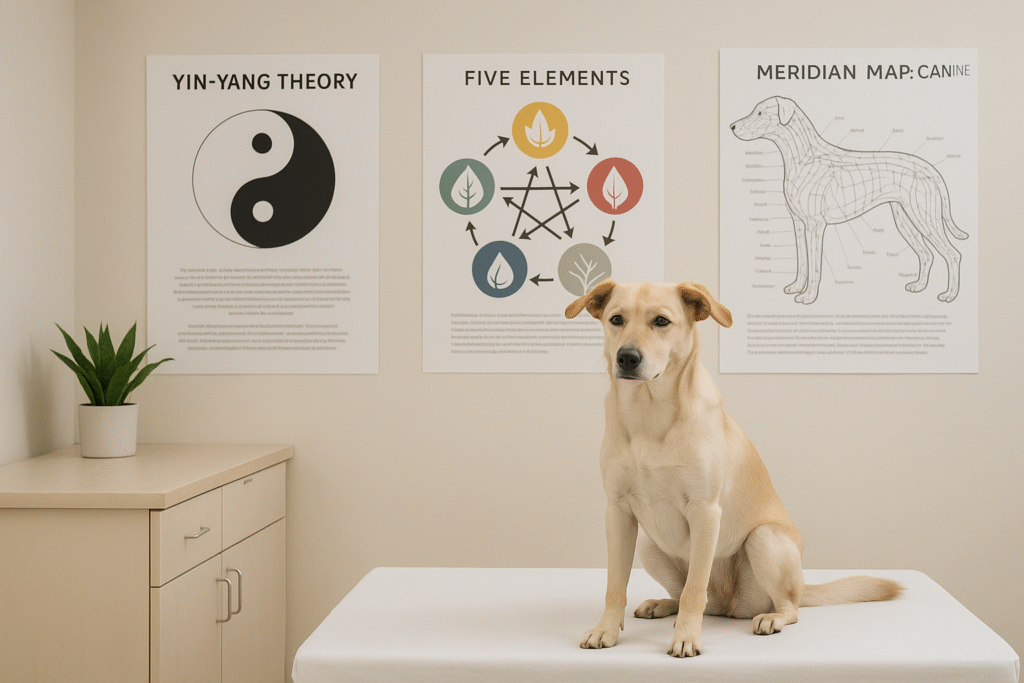
Traditional Chinese medicine for dogs is rooted in the ancient healing practices of Traditional Chinese Medicine (TCM), a 3,000-year-old system developed for humans that has been successfully adapted for animals. In veterinary practice, this discipline is called Traditional Chinese Veterinary Medicine, or TCVM. It focuses on balance, prevention, and restoring the natural flow of life energy called Qi (pronounced “chee”) within your dog’s body.
Unlike Western medicine, which often targets symptoms, TCM for dogs seeks to understand and treat the root cause of illness. It views your pet as a whole mind, body, and environment making it a cornerstone of holistic dog care.
Key Philosophies of TCVM
- Qi and Meridians: Qi flows through channels known as meridians. Blockages or imbalances in Qi can lead to illness, pain, or behavioral issues.
- Yin and Yang: These represent cooling/restorative versus heating/stimulating energies. Healthy dogs maintain a balance between the two.
- The Five Elements: Wood, Fire, Earth, Metal, and Water symbolize organ systems and emotional traits. Imbalances in one element can affect others.
- Pattern Diagnosis: Rather than diagnosing a disease name, TCVM for dogs identifies the pattern (e.g., Qi deficiency, Damp-Heat) driving the symptoms.
Having used traditional Chinese medicine for dogs in my own practice especially for senior dogs with arthritis and patients undergoing cancer treatment I’ve witnessed first-hand how powerful this approach can be when personalized and consistent.
Core Concepts of TCVM in Canine Care
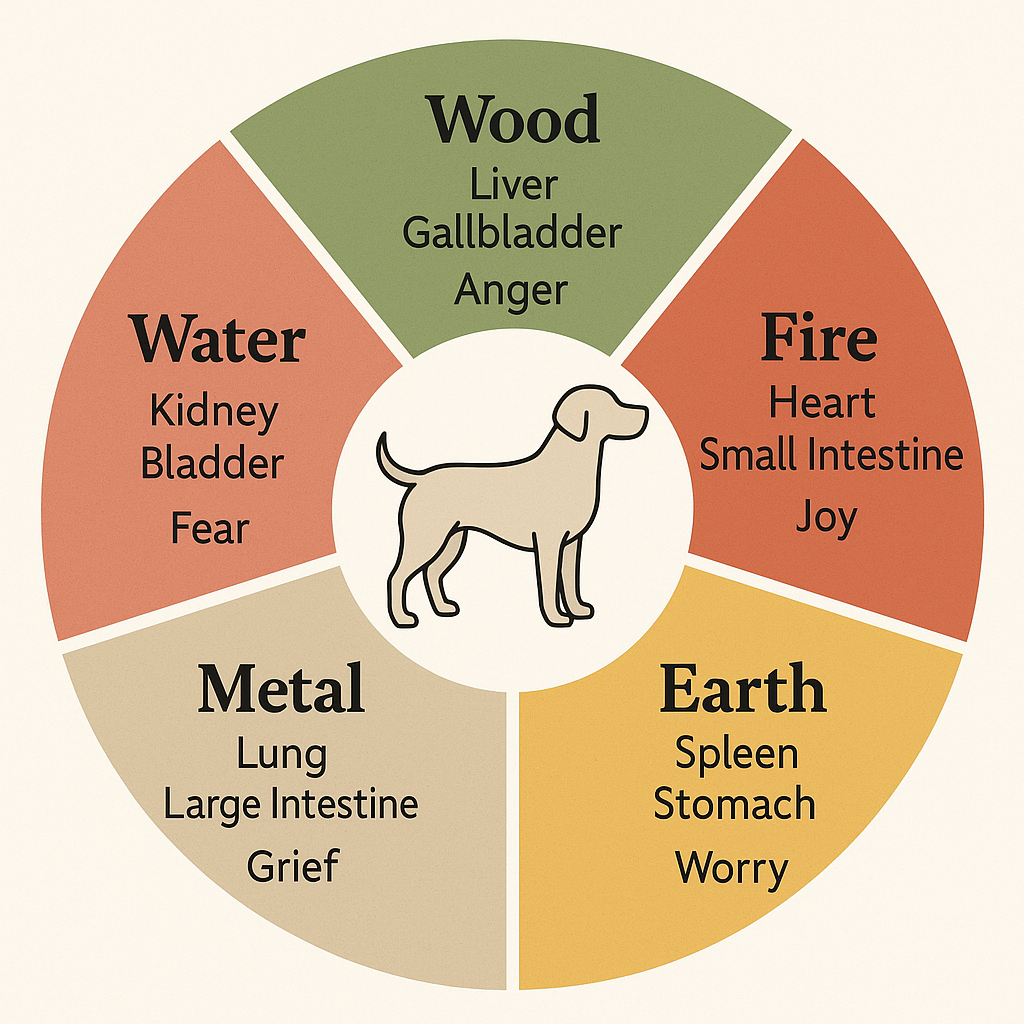
Understanding how traditional Chinese medicine for dogs works starts with its foundational theories. These principles help guide every treatment decision in TCM for dogs, from food choices to acupuncture points.
Qi, Meridians, and Pattern Diagnosis
- Qi is the body’s vital life force. It circulates through meridians, which connect organs and tissues.
- When Qi is blocked or deficient, illness can develop.
- TCVM vets use tools like tongue and pulse diagnosis, physical exams, and behavioral cues to identify a dog’s unique imbalance or “pattern.”
- A dog with digestive issues, for example, may be diagnosed with Spleen Qi Deficiency or Damp-Heat in the intestines not just “IBD.”
Yin and Yang Balance
In holistic dog care, Yin and Yang must be in harmony. Yin is cooling, calming, and nourishing. Yang is warming, energizing, and stimulating.
- A dog that’s anxious, hot to the touch, and always panting may have a Yin deficiency.
- A lethargic dog that shivers in cold weather might need Yang-tonifying herbs and warming foods.
Five Element Theory
Each dog has a unique elemental constitution that influences their behavior, health risks, and organ strengths:
| Element | Organs | Emotion | Season |
|---|---|---|---|
| Wood | Liver, Gallbladder | Anger | Spring |
| Fire | Heart, Small Intestine | Joy | Summer |
| Earth | Spleen, Stomach | Worry | Late Summer |
| Metal | Lung, Large Intestine | Grief | Fall |
| Water | Kidney, Bladder | Fear | Winter |
A dog with recurring UTIs might have a Water imbalance, while a reactive, itchy dog could show Fire or Wood excess. Recognizing these patterns allows TCM for dogs to go far beyond symptom suppression.
Key TCVM Modalities for Dogs
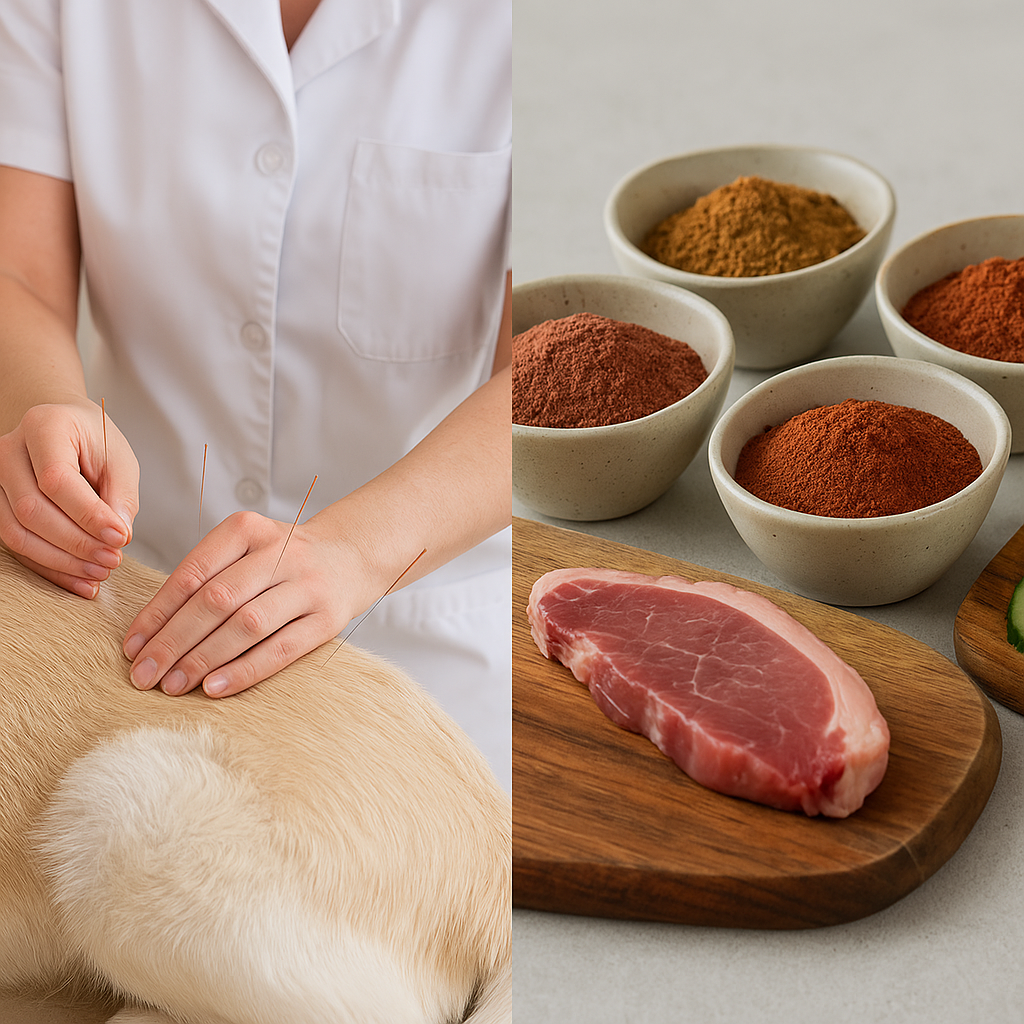
One of the strengths of traditional Chinese medicine for dogs is its diverse treatment toolbox. TCVM blends time-tested techniques that aim to restore balance and support the whole dog not just address isolated symptoms.
1. Acupuncture
Acupuncture involves inserting tiny, sterile needles at specific meridian points to stimulate Qi flow, reduce pain, and support organ function.
In my practice, I’ve used acupuncture to help dogs recover from intervertebral disc disease, manage arthritis, and even ease anxiety. Many dogs relax or fall asleep during sessions.
- Best for: Arthritis, back pain, paralysis, allergies, anxiety, seizures, GI issues.
- Frequency: Weekly to monthly depending on severity.
- What to Expect: Sessions last 20–40 minutes. Improvement is usually noticeable after 3–6 treatments.
Evidence: A 2017 study in the Journal of Veterinary Internal Medicine showed that acupuncture combined with conventional care improved recovery in dogs with spinal disc disease.
2. Herbal Medicine
TCVM uses plant- and mineral-based formulas that target specific patterns like Qi stagnation or Damp-Heat. Unlike generic supplements, these are custom-prescribed based on TCVM diagnosis.
Common TCVM Formulas for Dogs:
- Yunnan Baiyao: Controls bleeding (often used in hemangiosarcoma).
- Shen Tong Zhu Yu Tang: Alleviates joint and spinal pain.
- Xue Fu Zhu Yu Tang: Moves blood, helpful for cancer and heart conditions.
- Wei Qi Booster: Supports immune health.
- Chai Hu-based formulas: Relieve emotional tension and anxiety.
Always use formulas from reputable suppliers like Jing Tang Herbal and only under a TCVM-trained vet’s guidance.
3. Food Therapy
TCM for dogs considers food a powerful form of medicine. Each food has an energetic quality cooling, warming, or neutral.
| Condition | Recommended Foods |
|---|---|
| Hot conditions (itchy skin, allergies) | Duck, rabbit, cucumber, whitefish |
| Cold conditions (lethargy, arthritis) | Lamb, chicken, ginger, oats |
| Balanced support | Pork, sweet potato, millet |
- Raw or lightly cooked diets are often preferred.
- Feed smaller, frequent meals to ease spleen stress.
- Adjust diets by season cooling foods in summer, warming in winter.
Brands like PET | TAO align diets with TCVM principles.
4. Tui-na (Chinese Massage)
Tui-na combines acupressure, joint mobilization, and massage to support Qi and circulation. It’s excellent for senior dogs, post-op recovery, or pets who dislike needles.
- Owner Tip: Your TCVM vet can teach you basic at-home Tui-na techniques.
- Benefits: Non-invasive, relaxing, supports physical and emotional balance.
5. Exercise and Movement Therapy
Just as humans use Tai Chi or Qi Gong, TCM for dogs values gentle movement to support healing.
- Examples: Leash walks, slow hill climbs, underwater treadmill, guided stretching.
- When used: During rehab, for weight control, or to maintain mobility in older dogs.
These modalities can be combined for optimal effect. For example, a dog with arthritis may receive acupuncture, eat a warming diet, take Shen Tong Zhu Yu Tang, and get weekly Tui-na.
Conditions That TCVM Can Help Manage

In clinical practice, I’ve used traditional Chinese medicine for dogs to manage a wide range of chronic conditions—many of which showed limited response to conventional treatment alone. Here’s how TCM for dogs can support various health challenges.
1. Musculoskeletal Disorders
Common issues: Arthritis, hip dysplasia, cruciate ligament injuries, IVDD.
- TCVM tools: Acupuncture relieves pain and inflammation. Herbs like Shen Tong Zhu Yu Tang support joint mobility. Warming diets (e.g., lamb and ginger) improve circulation and comfort.
- Real-life: Senior dogs often return to climbing stairs or playing again after a few weeks of treatment.
2. Cancer
Common issues: Hemangiosarcoma, mast cell tumors, lymphoma.
- TCVM tools: Herbs like Yunnan Baiyao reduce bleeding and pain. Acupuncture helps manage energy loss, nausea, and anxiety. Cooling foods combat inflammation.
- Caution: Herbal support is not a replacement for chemotherapy or surgery but can enhance quality of life.
3. Digestive Disorders
Common issues: IBD, chronic diarrhea, vomiting, constipation.
- TCVM tools: Food therapy with duck, rabbit, or sweet potato; herbs like Bai Zhu and Huo Xiang for gut balance; acupuncture to tone spleen and stomach Qi.
- Bonus: Smaller, frequent meals often reduce GI flare-ups.
4. Kidney and Liver Disease
Common issues: Chronic kidney disease, liver inflammation, hepatic shunts.
- TCVM tools: Herbs like Rehmannia or Milk Thistle (under veterinary supervision), acupuncture to boost kidney Yin or liver Qi, neutral foods like pork and millet to nourish without taxing organs.
5. Skin Conditions
Common issues: Allergies, hot spots, yeast infections, chronic itching.
- TCVM tools: Cooling foods (e.g., whitefish, cucumber), herbal formulas to clear Damp-Heat, acupuncture for itch relief.
- Result: Many dogs need less reliance on steroids over time.
6. Immune & Endocrine Conditions
Common issues: Cushing’s disease, diabetes, immune suppression.
- TCVM tools: Wei Qi Booster to strengthen immunity, acupuncture to support hormone regulation, neutral/warming diets to stabilize energy.
- Note: TCVM can’t cure endocrine diseases but improves comfort and vitality.
7. Behavioral Issues
Common issues: Anxiety, fearfulness, aggression, noise phobia.
- TCVM tools: Chai Hu-based herbs for emotional tension, acupuncture for calming Shen (spirit), Tui-na to relax tense muscles.
- Good fit: Rescue dogs, dogs with PTSD, or separation anxiety.
8. Respiratory & Urinary Problems
Common issues: Asthma, kennel cough, bronchitis, incontinence, recurrent UTIs.
- TCVM tools: Herbs that support lung Qi or bladder strength, acupuncture for cough suppression or sphincter tone, dietary tweaks (cooling or warming) depending on pattern.
Across all these categories, holistic dog care through TCVM supports healing from the inside out often improving not just symptoms but energy, appetite, and emotional well-being.
How to Start TCVM for Your Dog

Beginning your holistic dog care journey with traditional Chinese medicine for dogs doesn’t have to be overwhelming. Follow this step-by-step guide to integrate TCVM safely and effectively into your pet’s routine.
✅ 5-Minute Home Checklist: Is TCVM Right for My Dog?
- Has your dog’s condition plateaued with Western treatment?
- Are you managing a chronic issue like arthritis, IBD, or anxiety?
- Do you prefer natural, preventive care?
- Is your dog aging or recovering from surgery?
- Are you open to herbs, acupuncture, or diet change?
If you checked 2 or more boxes, TCVM for dogs could be worth exploring.
Step 1: Find a TCVM-Certified Vet
Look for veterinarians certified in TCM for dogs through trusted organizations:
- Chi University – Formerly Chi Institute
- AHVMA.org – American Holistic Veterinary Medical Association
- IVAS.org – International Veterinary Acupuncture Society
Some offer telehealth consultations for food therapy and herbs. However, acupuncture must be done in person.
Step 2: Get a TCVM Diagnosis
During your initial visit, the vet will examine:
- Tongue & Pulse: A red tongue might show heat, a weak pulse suggests Qi deficiency.
- Coat, Eyes, Energy: All reveal internal imbalances.
- Behavior Patterns: Anxiety, aggression, or sluggishness offer diagnostic clues.
This assessment leads to a custom diagnosis like “Kidney Yin Deficiency” or “Damp-Heat in Liver” rather than a Western label like “arthritis.”
Step 3: Start with Food Therapy
Food is the most accessible and non-invasive TCVM tool. Your vet will build a diet plan based on your dog’s condition:
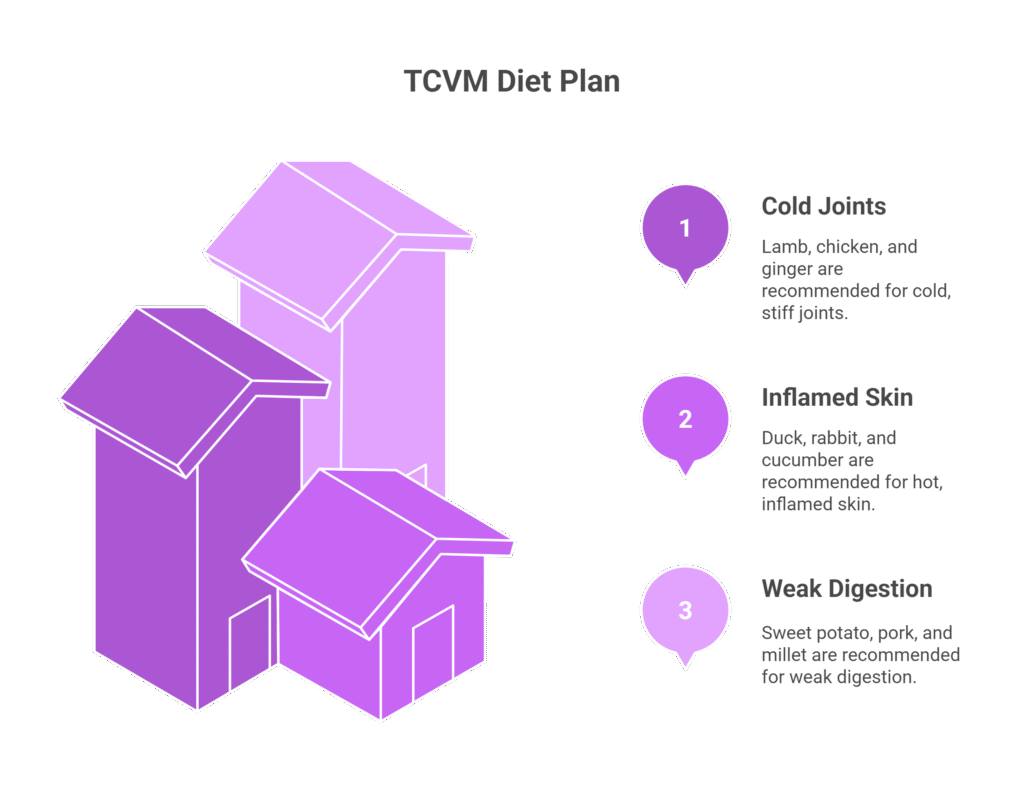
Gradually transition over 7–10 days to avoid GI upset. Feed warm or room-temp meals, not cold from the fridge.
Step 4: Add Acupuncture or Massage
Book acupuncture sessions if your dog has:
- Pain, mobility issues, allergies, or anxiety
- Cancer-related discomfort
- Poor energy or recovery after illness
Also consider Tui-na for older or needle-shy dogs. Your vet can teach you simple techniques for at-home care.
Step 5: Use Herbs Safely
Only give TCVM herbs prescribed by a certified vet. Do not use over-the-counter blends without guidance.
- Use brands like Jing Tang or Kan Herb Company with batch testing and purity standards.
- Watch for changes in stool or appetite and report them.
- Follow dosage instructions carefully.
Step 6: Coordinate with Your Regular Vet
TCVM works best alongside Western care. Keep your primary vet in the loop so they can:
- Monitor bloodwork or imaging
- Adjust medications if symptoms improve
- Avoid drug-herb interactions
This collaborative approach ensures your dog gets the best of both worlds.
TCVM Success Stories: Real-World Case Studies
These real-world examples illustrate how traditional Chinese medicine for dogs can create dramatic improvements in quality of life even when conventional care alone hasn’t delivered full relief.
Case 1: Max, a 10-Year-Old Labrador with Arthritis
- Problem: Stiff, painful hips; struggles to climb stairs.
- TCVM Diagnosis: Kidney Yang Deficiency with Qi stagnation.
- Treatment Plan:
- Biweekly acupuncture for joint inflammation.
- Shen Tong Zhu Yu Tang to support joint circulation.
- Warming diet: lamb, oats, ginger.
- At-home Tui-na massage taught to his owner.
- Result: Max resumed walking longer distances, had less joint stiffness, and climbed stairs with ease after 6 weeks.
Case 2: Bella, a 7-Year-Old Boxer with Hemangiosarcoma
- Problem: Diagnosed with splenic cancer; on chemotherapy.
- TCVM Diagnosis: Blood stagnation with underlying Qi deficiency.
- Treatment Plan:
- Yunnan Baiyao to reduce internal bleeding episodes.
- Weekly acupuncture for nausea and fatigue.
- Cooling diet: whitefish, cucumber, quinoa.
- Emotional support via calming Chai Hu-based herbs.
- Result: Bella’s energy improved, her appetite returned, and she lived 5 months longer than expected happily and comfortably.
Case 3: Coco, a 5-Year-Old Beagle with Chronic IBD
- Problem: Frequent vomiting and diarrhea, even with prescription diets.
- TCVM Diagnosis: Damp-Heat in the spleen and intestines.
- Treatment Plan:
- Cooling, low-fat raw diet: duck, broccoli, sweet potato.
- Twice-monthly acupuncture to regulate digestion.
- Herbs including Bai Zhu and Huo Xiang.
- Feeding 4 smaller meals per day.
- Result: Within a month, Coco’s stools normalized, vomiting stopped, and steroid use was discontinued.
Each of these dogs benefited from TCM for dogs as a complementary tool not a replacement for Western care. Their outcomes show what’s possible with a thoughtful, integrative approach to holistic dog care.
Costs and Considerations in Canada
While traditional Chinese medicine for dogs offers many benefits, it also requires time, commitment, and some financial planning. Here’s what you can realistically expect in terms of cost and other key factors in Canadian veterinary practice.
Typical Canadian TCVM Costs (2025 Estimates)
Some pet insurers (e.g., Trupanion, Petsecure) may reimburse TCM for dogs under alternative or complementary care check your plan.
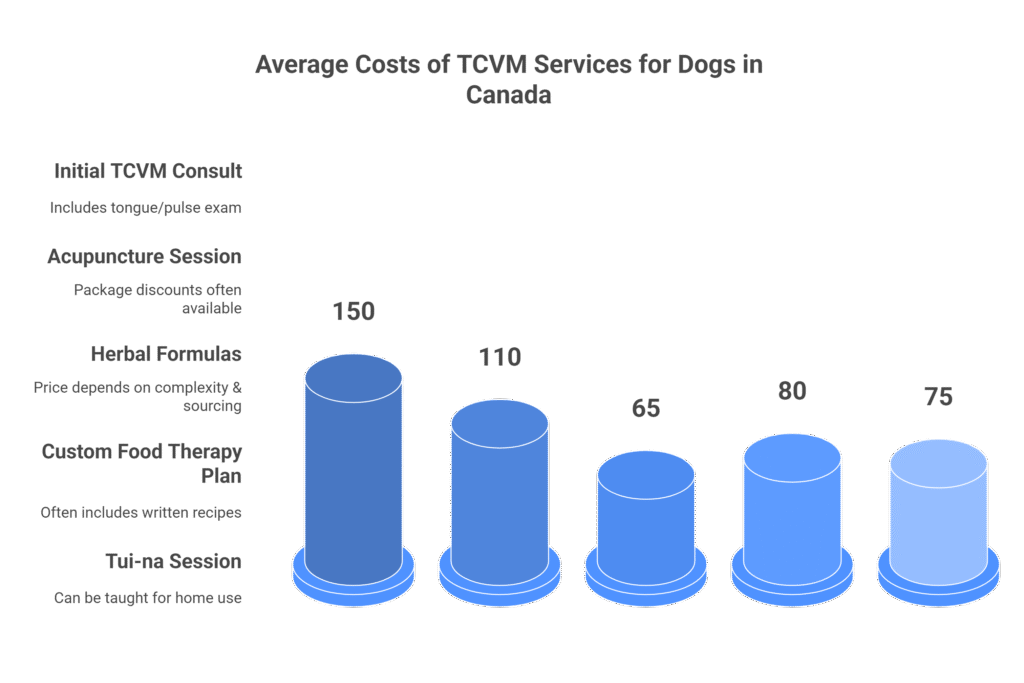
Key Considerations
Pros of TCVM:
- Gentle and holistic with minimal side effects
- Treats chronic, complex issues more naturally
- Customizable care for every pet
- Complements Western diagnostics and medications
Cautions:
- Herbs can interact with medications always disclose all treatments
- Not all vets are TCVM-trained
- Herbal taste can be off-putting to picky dogs
- Clinical evidence is still emerging for some TCVM claims
In my experience, clients who commit to holistic dog care through TCVM often see significant improvements in comfort, digestion, behavior, and longevity even if they initially came for “last-resort” treatment.
Preventing Disease with TCVM
One of the most empowering aspects of traditional Chinese medicine for dogs is its focus on prevention. Rather than waiting for disease to manifest, TCM for dogs emphasizes maintaining balance to keep your pup thriving.
Seasonal Food Adjustments
Aligning your dog’s diet with the seasons is a fundamental part of holistic dog care:
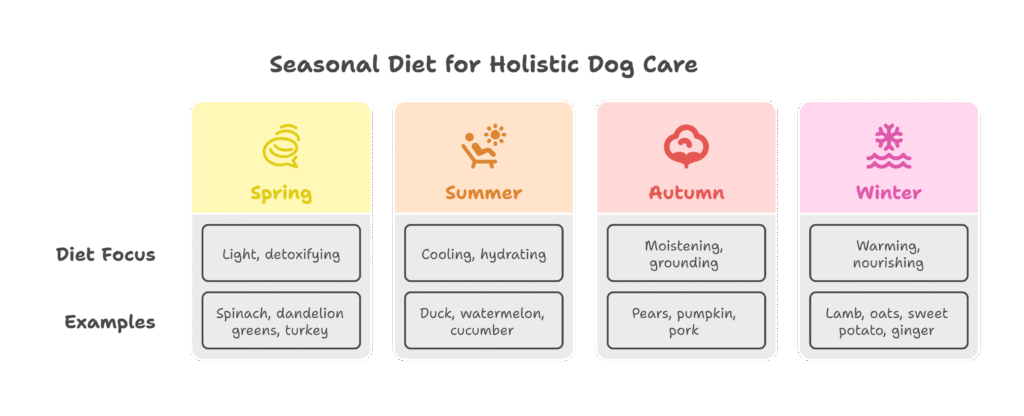
These shifts support the organ systems linked to each season, helping prevent imbalances that may otherwise lead to illness.
Routine Acupuncture for Balance
Even healthy dogs benefit from monthly or seasonal acupuncture. It supports:
- Immune system function
- Emotional resilience (especially in reactive or anxious dogs)
- Organ health, especially in seniors
In my clinic, older dogs often begin monthly TCVM sessions for arthritis but continue them even after symptoms subside because they sleep better, eat more steadily, and simply “feel better.”
Herbal Tonics for Maintenance
Some formulas like Wei Qi Booster are prescribed as preventive tonics, especially for:
- Senior dogs with weakened immunity
- Dogs prone to infections or respiratory issues
- Post-surgical recovery to speed healing
These should still be prescribed by a trained TCVM vet and not used casually.
Calm Body, Calm Mind
Daily routines matter. From a TCVM perspective, dogs thrive with:
- Regular meals and walks
- Calm environments (reduce noise stressors)
- Warm sleeping areas, especially for senior or cold-sensitive dogs
These lifestyle strategies, alongside periodic TCM for dogs, help ensure long-term wellness.
FAQs About Traditional Chinese Medicine for Dogs
These are the most common questions I hear in clinic about TCM for dogs. Let’s clear up some myths and concerns:
Is traditional Chinese medicine safe for dogs?
Yes when prescribed by a certified TCVM vet using quality-controlled herbs. Acupuncture is safe, minimally invasive, and often well-tolerated. Avoid using over-the-counter herbs without professional guidance.
How long does it take to see results?
- Acute issues: 1–3 sessions may be enough (e.g., recent sprain).
- Chronic problems: Allow 4–8 weeks for full benefit (e.g., arthritis or IBD).
- Food therapy: Digestive improvement is often visible within 2–3 weeks.
Can TCVM replace my regular vet?
No. Holistic dog care through TCVM works best alongside Western veterinary diagnostics and medications. Always keep both vets informed.
Is TCM for dogs expensive?
It can be affordable long-term. Many conditions require fewer medications or surgeries once managed with TCVM. Herbs and acupuncture can reduce the need for frequent vet visits or chronic drugs.
Can I do any of this at home?
Yes. Food therapy, Tui-na massage, seasonal routines, and herbal compliance can all be maintained by the pet parent with guidance from your vet.
Is there scientific proof it works?
More studies are emerging. Acupuncture has growing veterinary research support. Herbal medicine and food therapy rely on thousands of years of case-based evidence, but peer-reviewed trials are still building.
Final Thoughts: Is TCVM Right for Your Dog?
Whether your dog is battling arthritis, recovering from surgery, or simply slowing down with age, traditional Chinese medicine for dogs offers a powerful and natural approach to healing. Backed by centuries of practice and increasingly integrated with modern veterinary care, TCM for dogs helps restore energy, ease chronic symptoms, and support long-term wellness.
As a Canadian veterinarian, I’ve seen firsthand how dogs thrive with personalized, holistic dog care that addresses both the visible symptoms and underlying imbalances. From calming anxiety to improving mobility, TCVM meets your dog where they are and supports where they’re going.
If you’re considering this path, the next best step is to connect with a TCVM-certified veterinarian, start with diet and lifestyle adjustments, and see how your dog responds. In many cases, you’ll notice your pet seems not just better but brighter.

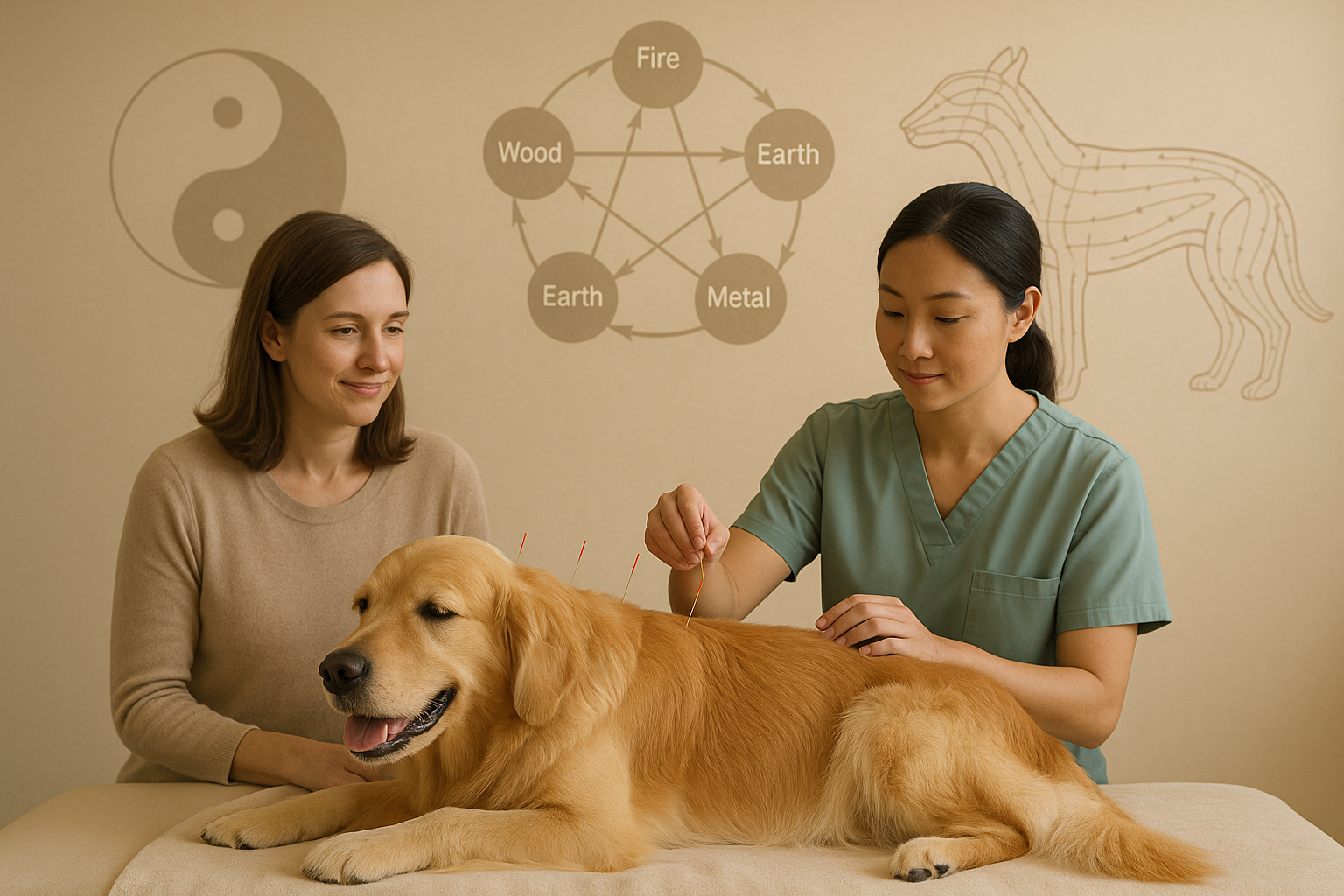



Pingback: Seasonal Allergies in Dogs: 7 best Vet-Approved Ways to Ease